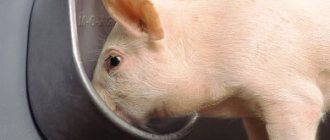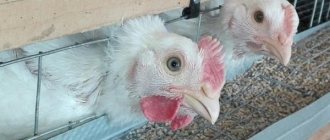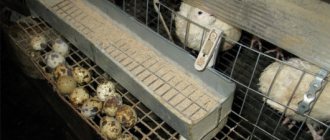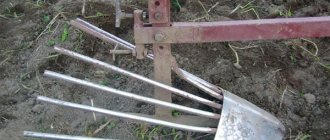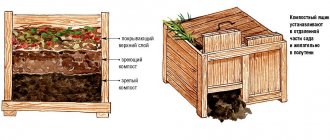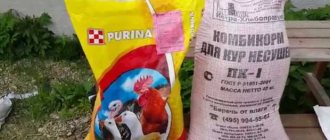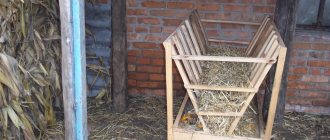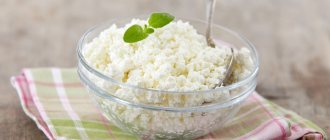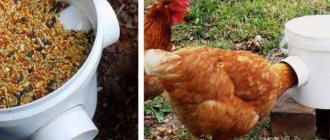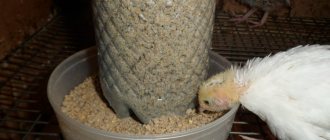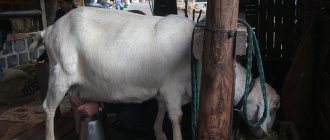Feeding pigs with compound feed
Combined feed is a suitable nutrition option for farm animals. It contains the optimal amount of mineral elements and vitamins, which creates conditions for the normal development of the animal. However, the pig's diet should also include raw and boiled vegetables, dietary supplements and herbs.
Important! When consuming feed, pigs must drink enough water.
Since pigs have a single-chamber stomach, it is recommended to use combined feeds to obtain high-quality meat, and juicy foods and green mass should be fed less frequently.
At the same time, compound feeds have their pros and cons.
- Advantages:
- providing adequate nutrition;
- the product does not have any harmful bacteria;
- ease of transportation and storage;
- there is no need for additional feeding;
- the result is excellent meat;
- rapid weight gain.
- Flaws:
- risk of obesity (this can be avoided by using dietary types);
- it is necessary to strictly adhere to the norm, without going beyond the permissible quantity;
- the monotony of the diet does not have a very good effect on the quality of life; periodic changes in food are required;
- Compound feeds are not suitable for all breeds.
Important! In some varieties of pigs (for example, Vietnamese), mixed feeds can upset digestion.
Which is better
It is difficult to give an unambiguous answer to the question posed. If you prepare the feed yourself, sometimes the farmer has no doubts about the composition of the feed. In addition, it becomes possible to independently vary the filling of the mixture at your own discretion.
But preparing compound feed yourself makes sense only if the farmer has access to a food base. After all, to obtain feed it is necessary to use grass, root crops, and grain. If you have to purchase grain for this, it is impossible to prove that the resulting feed will be environmentally friendly and natural. Also, the farmer will have to master various options for preparing compound feed, because for a certain age of the pig it is necessary to use specific components in the feed. It is much easier to purchase finished products.
This information will help you understand how long a pregnant pig walks.
Composition of feed for pigs
Combined feed is food for animals that is balanced in composition: it consists of valuable nutritional components, microelements and vitamins. The composition of mixed products is determined by the state standard. According to the standards, special pork feed includes 7–12 components, as well as additional ingredients that each manufacturer adds at its own discretion.
The following drugs are used as additional components:
- premix;
- feed chalk;
- nutritional yeast, etc.
Boars, breeding pigs and piglets need different amounts of proteins and minerals, i.e., different compounds are needed for each category.
Find out what pig growth stimulants are for and how to use them.
For adults
Fermented feed for mature pigs will be considered complete if its composition looks like this (in percentage):
- barley - 27;
- oats - 26;
- grass meal (alfalfa) - 18;
- meat and bone powder - 16;
- sunflower waste - 9;
- food chalk - 2;
- salt - 1.
The components in feed mixtures can be stationary; only their concentration will change. The quality characteristics of the special feed do not suffer.
For young animals
Let's look at what piglet feed is made from. So, special food for babies up to 90 days includes the following ingredients (in%):
- barley flour - 47;
- milk powder - 21;
- legume powder - 15.3;
- fish powder - 4;
- premixes - 3.78;
- fats of animal origin - 3.5;
- sucrose - 2.4;
- yeast for animals - 1.5;
- calcium carbonate - 0.5.
For piglets up to 2 months old, the concentration of milk powder is reduced to 9.3% and corn powder and bran are added to the feed mixture, while simultaneously reducing the portion of barley and legume flour.
Important! It is not recommended to reduce the premix content below 2.57%.
Kinds
Today, several varieties of combined feeds are produced, which differ in their form, purpose and other indicators.
By release form
Based on their external form, feed can be dry powdered or granulated.
loose
This kind of food, according to professionals, is best used in pigsties with a good ventilation system. And to the place where piglets are fed, it should be fed using a sealed structure into special closing feeders.
Granulated
Granules are the most acceptable option for special food, because during the production of such a product, all fungi that are capable of producing toxins are destroyed. In addition, the quality of such combined feeds is many times higher than dry ones.
By purpose
According to the function they perform, mixed feeds are of two types: complete (PC) and concentrated (CC).
Full
Balanced feed, which contains all the essential elements for proper nutrition of pigs. It is an independent, complete feed product and does not require auxiliary feeding.
Did you know? Wild boars can feed on carrion (small birds and mammals), and
they consume worms and insects.
As a rule, complete feeds are labeled “PC 5X-X” or “SK X”, where X is a number that determines the intended purpose of a particular drug and its composition.
They are used both in pure form and in the form of mixtures, in a certain ratio to the main feed.
Concentrated
Often such feeds are called BMVP (protein-mineral vitamin supplements), since the bulk of their composition is occupied by proteins, vitamin components and minerals. Used in mash mixtures, to enrich mixed feed and grain mixtures prepared with one’s own hands.
Consumption standards
The amount of feed consumed must be strictly measured. If pigs are given too much food, obesity will occur, which affects the quality of the meat. To calculate how much food to give pigs, take into account the age, weight, sex and variety of the animal. It is according to these parameters that nutritional standards are written.
Pigs under the age of two months are considered dairy animals. This is how much special feed a suckling pig normally eats per day:
- 1–14 days - 25 g;
- 15–60 days - 350 g;
- two month old pig – 850 g.
Find out how many years pigs live at home and in the wild.
The next stage in the life of a pig is called the growing phase - these are pigs at the age of 2-4 months. The daily dose for such babies is:
- 3 months - 1050 g;
- 4 months - 1550 g.
The next period is the fattening phase. Such pigs include representatives weighing up to a hundredweight and up to eight months old. The calculation of food per day for this category looks like this:
- up to 5 months - 2250 g;
- six months - 2550 g;
- 7 months - 3200 g;
- 8 months - 3300–3400 g.
Important! If feed is calculated incorrectly in pigs, the function of the digestive system is disrupted.
The volumes of feed in the distribution by category look like this:
- 21–40 days — 10–11 kg;
- 41–60 days — 23–24 kg;
- 61–90 days — 53–54 kg;
- 91–120 days — 69–70 kg;
- 121–150 days — 82–83 kg;
- 151–180 days - 93–94 kg.
Experienced pig breeders remove cake, soybeans and oats from the pig’s diet before slaughter.
Grown animals will need the following amount of mixed product per day:
- pigs for slaughter - 3 kg;
- pigs for offspring - 3 kg;
- during lactation - 3–4 kg.
It is worth noting that the consumption rates for each feed mixture depend not only on the age and purpose of the pig, but also on the manufacturer. Each individual product indicates the norm per day. For example, to raise a pig, Soyuzpischeprom offers the following dosage:
| Product code | Age category | Consumption per day, grams |
| SK-1 | sows (single, farrowing); boars; young animals for replacement | 2500–3500 |
| SK-2 | lactating sows; breeding boars | initially 1500–2000, gradually increasing to 6500 (15–18 days of lactation) |
| SK-3 | piglets 9–42 days old | 15–550 |
| SK-4 | babies 43–60 days | 650–850 |
| SK-5 | pigs 61–105 days. | 850–1550 |
| SK-6 | 1st period for fattening (106–150 days) | 1650–2150 |
| SK-7 | 2nd phase of fattening (151–210 days) | 2250–3200 |
| KK-56 | bacon feeding (91–220 days) | 1250–3350 |
| KK-58 | fattening for fatty products (100–280 days) | 1800–3100 |
Did you know? For good growth, the best option would be piglets obtained from crossing different breeds.
Provimi produces the following feed mixtures for pigs with the following dosage:
| Product code | Age category | Daily value, grams |
| prestarter "Bogatyr" | suckling pigs (3–45 days) | 120 |
| "Starter" | weaned piglets (45–48 days) | 1125 |
| "Grower" | pigs during growing (85–125 days) | 2125 |
| "Finisher" | fattening pigs (125–180 days) | 2910 |
| Replacement feed mixture for pigs | 15–30 days | 1500–3000 |
| For pregnant sows | 31–32 weeks | 2800 |
| "Profert" | pregnant sows (33–34 weeks) | 2800 |
| For breeding males | 270–400 days; 401–800 days; 801 days and older | 3200 3500 4000 |
As you can see, the consumption of special feed per head depends on the brand of the product.
Therefore, when choosing feed mixtures, it should be taken into account that for the healthy state and preservation of the productive functions and productivity of pigs (fat, meat and fat, meat, for reproduction), they must contain the required amount of nutritional components. It is also important to maintain a balanced diet so that the animal receives the required amount of mineral components and vitamins per day.
Did you know? The idea that pigs are dirty is wrong. They will never defecate where they eat. And the famous mud bathing is just a hygienic procedure: in this way the pig is saved from parasites.
With the right choice of norm, you get good, quick weight gain and high-quality meat. At the same time, it is taken into account that if the increase in the weight of adult individuals falls below 500 g per day, their rearing will no longer be profitable, i.e., the pig is either stopped fattening and sent to slaughter, or the standards are revised and a new special feed and its consumption are chosen.
The best feed producers
All agricultural producers must adhere to established standards that regulate the following parameters:
- Nutritional value. Control of the composition of digestible fiber, protein and the volume of feed units.
- Mineral set. The presence of sodium, potassium, phosphorus in the mixture.
- Grinding size. Feed can be produced in coarse, fine and medium grinding.
- Granule size. The acceptable granule size for rapid growth of animals is 10 mm. For small pigs just weaned from the sow - 8 mm.
Today, many companies offer special feed on the market, both domestic and foreign. Each of them has its own classification, consumption rate and recipes. The most popular are:
- — a foreign company specializing in the production of agricultural products;
- LLC Soyuzpischeprom Association is an organization from the Russian Federation.
Not long ago, Provimi released an updated line of Purina mixtures. As a standard, the company includes the following elements in its feed:
- enzyme complex;
- soy protein;
- antibiotic;
- acidifier;
- immunomodulator;
- heat-treated grain;
- antioxidant;
- dairy products;
- growth stimulants;
- animal components;
- mineral and vitamin supplements.
The updated version of the feed, unlike previous versions, does not contain animal and dairy feed. Today Purina consists of the following components:
- soybean meal and meal;
- methionine;
- phytase ENZIM;
- L-lysine;
- wheat, oats, corn;
- antioxidants and aromatic additives;
- vitamins and minerals.
Important! Phytase ENZIM is an essential element that helps break down phytic acid, stimulates weight gain, and improves the digestion process.
In addition, Purina contains practically no synthetic components.
Russian manufacturers are also keeping up with their American competitor. The products are of high quality and reasonable prices. Their assortment includes mixed feeds that are not only not inferior in quality characteristics, but even surpass them:
- SK-8. Complete feed mixture for pigs of the second fattening period. Contains enough protein, but is enriched with protein. Suitable for greasy and meat-producing animals. Contains mineral and vitamin components in optimal quantities and does not include hormones, growth stimulants, antibiotics and GMOs. The basis is barley, wheat, by-products of plant crops and cake.
- KK-55. Granulated feed mixture that contains feed barley and wheat, feed meal, meat and bone meal (30%), sunflower cake (36%), salt and edible lime, monocalcium phosphate. Crude protein content: 16%. The food is designed for raising animals to fatty condition. The manufacturer considers the absence of antibiotics to be an additional advantage.
- PC-55 beam. Ground feed for meat production. Contains the maximum amount of nutritional components, minerals and vitamins that help maintain health and good production. The composition also contains flavoring additives.
Did you know? The recipes of the best manufacturers are present in the popular game FS 17, in which everyone can feel like a farmer without leaving the comfort of their chair.
“Opened” grain and protein concentrates
The requirements for the components used in feed for piglets are very high. For example, “opened” grains are a mandatory raw material for them. Thanks to the intensive method of processing grain with heat and moisture ( extrusion, expansion ), the integral starch structure in the grain is destroyed.
The production of amylase for starch digestion is still in development in piglets. Heat treatment of grains supports starch digestion. Glucose is released faster, absorbed by the intestinal walls and becomes available for metabolism. In addition, “opening” the grain prevents the entry of a large part of undigested starch into the distant part of the small intestine and is thus a good prevention of diarrhea. With liquid feeding, water is bound by readily available starch into a homogeneous feed porridge, preventing feed separation.
Protein hydrolyzate in feed for piglets
Protein hydrolyzate is a by-product obtained from the enzymatic production of heparin from the small intestinal mucosa of pigs. The manufacturing process, which takes place under pharmaceutical conditions, produces a highly digestible hydrolyzed protein that is rich in peptides and free amino acids. Protein hydrolyzate has no restrictions on input.
The next source of amino acids obtained from animal sources is blood plasma
and
protein hydrolysate
.
Blood plasma refers to the liquid, cell-free component of blood that no longer contains red cells and other blood cells. Protein hydrolyzate is obtained from the tissues of the small intestine of slaughtered pigs. The set of amino acids of this product is very similar to the set of cells in the pig body (see the tab “Protein hydrolyzate in feed for piglets”). High and fast feed consumption and thus greater weight gain is a great advantage of this product. Potato protein
has proven itself well as a source of plant-based protein .
It contains about 74% crude protein with a good set of amino acids (high lysine content) and high digestibility. The next highly valuable component of piglet feed is protein concentrates . These are blood plasma, potato protein, soybeans, soybean concentrate or protein hydrolysate. In the first weeks of life, the activity of enzymes that break down proteins is still very low. This fact requires the use of highly digestible protein sources. Milk proteins ( skimmed milk powder, whey powder
) are very easily digestible and very tasty.
The use of soybean meal, on the other hand, for suckling piglets and piglets recently weaned from sows must be started very carefully. Soybean meal has a known allergenic effect on the gastrointestinal tract and increases the risk of digestive disorders. Of course, you should not completely abandon this product, so that the digestive system gets used to this usual source of protein in the later stages of growing and fattening. But it is better to use soy protein concentrates
.
How to make feed for pigs with your own hands
As we have already found out, for good results you should definitely feed the pigs with mixed feed. But the farmer always has a choice: buy a finished product or make it himself. The more cost-effective option, of course, would be the second. Having obtained all the ingredients and knowing the recipe, you can turn piglet breeding into a profitable business.
Ingredients and proportions
The best feeds are those based on grain crops. It, like other large elements, is crushed. Overall the consistency should be mushy.
Important! For sows, feed is prepared with one type of moderately ground cereal.
In general, mixed feed for fattening adult pigs should include the following components:
- barley - 300–400 g;
- oats - 250–300 g;
- alfalfa flour - 120–160 g;
- meat and bone powder - 110–120 g;
- sunflower cake - 70–80 g;
- chalk - 1 tbsp. spoon (20 g);
- salt - ½ tbsp. spoons (10 g).
Young piglets are given special feed only fine-grained or granulated. The consistency of the finished product is similar to a viscous porridge.
To produce a dry product for piglets, the following components are taken:
- barley - 1000 g;
- edible fat - 90–100 g or feed lard - 40 g;
- feed yeast - 90–100 g;
- chalk - 15 g;
- salt - 5 g.
Regardless of whether the feed is prepared independently or purchased, compliance with the proportions is the key to proper development, appropriate growth and productivity of pigs.
Step-by-step cooking instructions
The general scheme for mixing feed for both sows and gilts looks like this:
- All grain components are thoroughly washed and dried naturally (in the sun, indoors).
- A grain crusher is used to grind the grain and add other ingredients. Mix everything well.
- Heated water is added to the mixture and the mixture is brought to a dough consistency.
- The resulting material is passed through an extruder.
- The finished granules are dried.
Did you know? Pork is prohibited in certain religions. One of the legends says that with God’s mercy, the pig was lying on one side in the mud, but no one knows how, so it’s better not to eat it at all.
This way you can get granulated food, which is no different from an industrial product.
Recipe for fattening
To obtain fatty meat at home, it is recommended to use the following feed recipes:
- barley + oats – 690 g;
- Sunflower meal – 60 g;
- feed yeast – 60 g;
- herbal flour – 160 g;
- chalk – 10 g;
- salt – 10 g;
- premix – 10 g.
By eating good feed, your pig or boar will receive sufficient amounts of crude protein, fiber, lysine, crude fat and minerals every day. Meat gain will be maximum.
Options for recipes for preparing compound feed.
Do not forget that using the same recipe is not very good, since there may be an excess or deficiency of any nutrients.
To prevent this, knowledgeable pig breeders alternate recipes, one of which is this:
- wheat – 250 g;
- barley – 174 g;
- oats – 100 g;
- bran – 350 g;
- Animal BMK – 100 g;
- lime flour – 18 g;
- premix – 4 g;
- salt – 4 g.
Technological scheme for preparing mixed feed using the yeast method.
- Warm water is poured into a pre-prepared container with a capacity of 15–20 liters.
- Yeast is added in the amount of 100 g per 10 kg of dry feed.
- The feed is poured in and mixed thoroughly.
- Infusion of the mixture for 6 - 8 hours.
- The food is ready.
To prepare a yeast feed mixture, dry feed must be diluted with water and yeast.
How to feed pigs with compound feed
The feeding pattern, as well as the consistency, is different for adult pigs and babies. And if the ingredients included in the feed mixtures are almost similar, then the diet itself has differences.
Young piglets
Feeding piglets requires a special approach. The mixture can have different consistencies:
- Liquid. 3 parts of food are diluted in 1 part of water.
- Thick. 2.5 parts of feed are diluted with 1 part of water.
- Gruel. The proportions of feed to water are 2:1.
- Sticky porridge. 1 part water is added to 1.5 parts feed.
- Wet scattering. Liquid and feed mixture are taken in equal proportions.
- Dry scattering. 1 part food to ½ part water.
For small piglets, wet mash or thick porridge is best. The grain component should not be steamed or cooked - it loses most of the nutrients. The food temperature should be around +30–35 °C.
You can mix carrots, peas, bread products, potatoes, and beets into the food. The liquid is added immediately before feeding, otherwise the food may spoil and cause stomach upset.
Adults
Grown pigs are fed depending on their weight standards and intensity of use (meat standards, producers, sows). The diet (at least 70%) should be based on easily digestible food.
Important! The diet also depends on the time of year.
As additional products, you can give bran, vegetables, biofeeds, grass flour, corn and barley crumbs. Producer boars must be given millet (25% of the diet), skim milk and animal products. Regarding the question “does males need to be fed more often?” experienced pig breeders argue that it is better to feed boars twice a day.
Pregnant sows are fed depending on their age and gestation period. At this time, in addition to feed, they are given greens, potatoes, bean hay, and mineral supplements.
Preparing feed before serving
Any food for pigs undergoes mandatory processing. There are several types of it, which include:
1. Biological - fermentation of products, leavening, acidification, germination and yeasting. This is to ensure that the food contains as many nutrients as possible.
2. Mechanical. It means cutting, crushing and mixing. It is necessary that the food is well absorbed in the animal’s digestive system. Otherwise, the whole grain will simply pass out in the feces.
3. Physical. It is necessary in order to saturate food with useful elements and for optimal eating by animals.
4. Chemical. It uses acid and alkali to break down heavy nutrients in food.
Yeasting - what is it?
Yeasting of products is used to increase appetite, enrich with beneficial microelements and stimulate weight. For this purpose, baker's, brewer's and hydrolysis yeast are used. The procedure takes a short amount of time and involves at least 30 percent of the animal’s daily diet.
Yeasting is done in two ways - by sourdough and by the straight method. The starter is prepared as follows: one pack of yeast is diluted in 6 liters of warm (no more than 40 degrees) water and the mixture is left for 2 hours. Grain crops, mixed feed and food waste are poured there and again left for a couple of hours. 7 liters of water are poured into the container with the mixture, 3 kilograms of dry concentrated feed are added. After five hours the food is ready.
The second method is the most convenient and easiest. A packet of yeast is diluted in twenty liters of warm water (about 40 degrees) and left to infuse for one hour. Then ground grains and other products are gradually poured into the liquid. The feed mixture itself will be ready in eight hours.
Features of food preparation
Before serving, all vegetables must be thoroughly washed from dirt and boiled, because raw vegetables are poorly digested in the animal’s stomach and lead to the fermentation process. It is worth noting that you should not pour potato water into the mixture. It is better to get rid of it, because it contains a toxic substance - solanine. Vegetables are finely chopped and combined with cereals and animal feed. It is recommended to add beets and carrots to the mixture along with the water in which they were boiled.
There is no need to prepare food for animals several days in advance. After all, its shelf life is very short, and everything will simply go bad.
Fresh and dry grass and cake should not be given in dry form. This food is rough for pigs, so it is soaked in boiling water three hours before serving. Fresh grass must be freed from the stems and finely chopped, and then it is added to the feed mixture. You should not prepare it in advance - it will wither.
All cereals are threshed and sprouted. Pigs need peas and other legumes for healthy growth, but should not be fed raw. Peas are boiled for thirty minutes, and other legumes are soaked in boiling water for sixty minutes. Before serving to young animals, grain crops are pre-fried until light brown. This provokes tooth growth in small piglets.
Pigs should be given only as much food as they can eat at one time. This is especially important when serving mash. If there is food left after lunch, you should get rid of it immediately.
